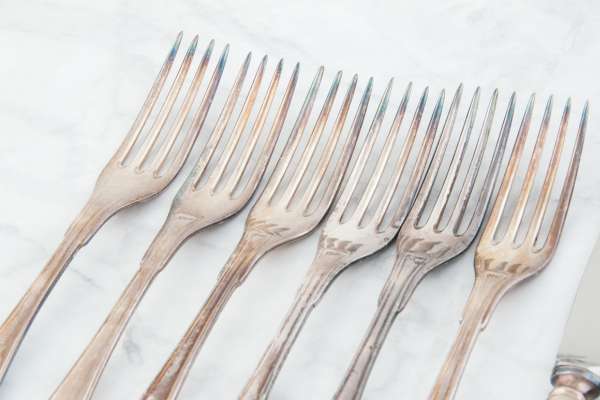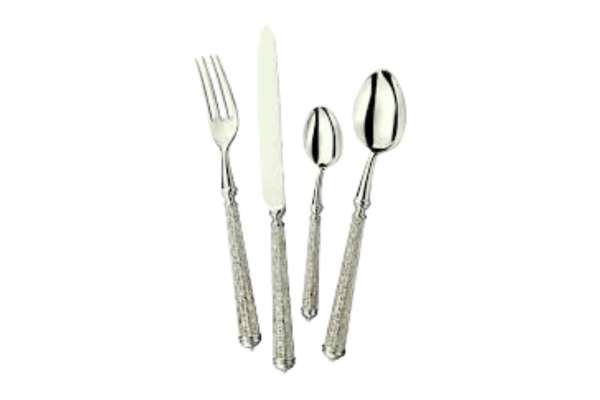Silverplate flatware is a popular and elegant choice for dining, but many people may not fully understand what it is and how it differs from other types of flatware. In this article, we will delve into the specifics of silverplate flatware, including its history, composition, benefits, and care instructions. This comprehensive guide will provide you with everything you need to know about silverplate spoons.
Introduction to Silverplate Flatware

flatware offers an elegant and cost-effective alternative to solid silver tableware. Crafted by bonding a thin layer of pure silver to a base metal, it combines durability with aesthetic appeal. This process results in a spoon that looks like solid silver but is much more affordable. Perfect for both everyday use and special occasions, the silverplate spoon maintains its luster with proper care. Its timeless design adds a touch of sophistication to any table setting, making it a popular choice among those who appreciate quality and elegance without the high cost of solid silver.
History of Silverplate Flatware

The history of silverplate flatware dates back to the mid-18th century when artisans developed a method to create an affordable alternative to solid silver. This innovative process involved coating a base metal, typically copper or nickel, with a thin layer of silver, resulting in a beautiful and durable spoon. Silver plating allowed more people to enjoy the elegance of silver dining utensils without the high cost. Over time, the tableware spoon became a staple in households and remains popular today for its blend of beauty and affordability. This historical technique revolutionized dining, making stylish table settings accessible to a wider audience.
Composition and Manufacturing Process

tableware flatware is crafted using a meticulous process that begins with a base metal, usually copper, brass, or nickel. This base is chosen for its durability and ability to bond well with silver. The spoon undergoes an electroplating process, where a layer of pure silver is applied evenly over the base metal. This method ensures a consistent and durable coating, giving the spoon its characteristic shine and luster. The result is a product that combines the strength of the base metal with the beauty of silver, making it a popular choice for elegant dining settings.
Benefits of Silverplate Flatware

Silverplate flatware offers several notable benefits. Firstly, it is cost-effective, providing an affordable alternative to solid silver while maintaining an elegant, luxurious appearance. This type of spoon is also highly durable, making it a practical choice for everyday use and special occasions alike. When properly cared for, tableware flatware is resistant to tarnish, ensuring it retains its shine and beauty over time. Additionally, its affordability and aesthetic appeal make it a popular choice for both casual dining and formal events. Embrace the elegance and practicality of silverplate spoons for a sophisticated dining experience without the hefty price tag.
Differences Between Silverplate and Sterling Silver

When choosing flatware, it’s essential to understand the differences between silverplate and sterling silver. Sterling silver flatware is composed of 92.5% pure silver, making it more valuable, and heavier, and requiring careful maintenance to prevent tarnishing. In contrast, flat silver spoon features a thin layer of silver over a base metal, making it more affordable but less durable over time. Silverplate items are lighter and easier to maintain but may wear down with frequent use. Knowing these differences helps you make an informed decision, ensuring your spoon meets your needs and expectations.
How to Identify Silverplate Flatware

Identifying flatware is straightforward when you know what to look for. Start by examining the spoon for specific markings or stamps. These engravings usually reveal the manufacturer and the quality of the silver plating. Common stamps include terms like “EPNS” (Electroplated Nickel Silver) or “EP” (Electroplate), indicating a silver coating over a base metal. Additionally, some pieces might have hallmarks or brand names etched into the metal. Understanding these marks can help you distinguish silverplate from solid silver, ensuring you accurately identify and evaluate your spoon. This knowledge is essential for collectors and enthusiasts.
Popular Patterns and Designs
Silverplate flatware offers an extensive selection of patterns and designs, catering to diverse tastes and decor styles. From classic and ornate motifs to sleek and minimalist looks, there is a perfect option for everyone. These varied designs allow consumers to express their personal style at the dining table. Whether you prefer the intricate detailing of traditional patterns or the clean lines of contemporary styles, silverplate spoons can enhance any dining experience. By choosing the right design, you can elevate your table setting and impress your guests, making each meal a special occasion.
Caring for Silverplate Flatware
Caring for silverplate flatware ensures it remains beautiful and functional for years. To maintain its shine, clean your spoon regularly with a mild soap and warm water. Avoid using abrasive materials or harsh chemicals, as these can damage the silver plating. After washing, dry each piece thoroughly to prevent water spots. Store your silverware spoon in a tarnish-resistant cloth or a lined storage box to protect it from tarnishing and scratches. By following these simple steps, you can keep your silverware spoon in pristine condition, enhancing your dining experience and preserving its value.
Cleaning and Polishing Tips
To keep your silverplate flatware looking its best, start by washing each piece with mild soap and water. Rinse thoroughly and dry with a soft, lint-free cloth to prevent water spots. When it’s time to polish, choose a special silver polish designed to restore shine and remove tarnish without harming the silver layer. Apply the polish with a clean, soft cloth, rubbing gently in a straight line. After polishing, rinse and dry each piece again to ensure no residue is left behind. Regular cleaning and polishing will keep your spoon looking beautiful and help maintain its value.
Storing Silverplate Flatware
Properly storing silverplate flatware is essential for maintaining its appearance and longevity. Always keep your spoon in a dry, cool place to prevent tarnishing. Use a flatware chest or a cloth-lined drawer to protect the pieces from scratches and damage. Avoid storing spoons in humid areas or direct sunlight, as these conditions can accelerate tarnishing. If possible, wrap each piece in an anti-tarnish cloth or use silver storage bags to provide an extra layer of protection. Regularly check your spoon for signs of tarnish and polish as needed to keep it looking its best.
Common Issues and Solutions
Common issues with silverplate flatware include tarnishing, scratching, and wear of the silver layer. To keep your flatware looking its best, regular maintenance is essential. Clean your spoon after each use and dry it thoroughly to prevent tarnish. Use protective storage solutions, such as tarnish-resistant cloths or bags, to minimize exposure to air and moisture. If your pieces become scratched or the silver layer wears thin, consider professional re-plating to restore their original luster. With these simple steps, you can preserve the beauty and functionality of your tableware spoon for years to come.
Investing in Silverplate Flatware
Investing in silverplate flatware is a wise decision for those who value fine dining and sophisticated table settings. High-quality tableware flatware offers durability and timeless elegance, often lasting for generations when properly maintained. This type of spoon not only enhances the aesthetic appeal of your dining experience but also holds potential value as a collectible item. Additionally, silverware flatware can be more affordable than sterling silver, providing a cost-effective option for luxury seekers. Whether used for special occasions or daily meals, investing in silverplate spoons can elevate your dining experience while offering long-term value.
Buying Guide: What to Look For
When purchasing silverplate flatware, consider several key factors to ensure quality and satisfaction. First, assess the quality of the silver plating. Opt for thicker plating to ensure durability and a longer lifespan. Second, research the reputation of the manufacturer. Established brands often provide more reliable and consistent quality. Third, evaluate the overall design and weight of the pieces. Choose a style that complements your dining aesthetic and feels comfortable to handle. By focusing on these aspects, you can make an informed decision and enjoy elegant, long-lasting silverplate flatware that enhances your dining experience.
Conclusion
Silverplate flatware offers a blend of elegance, durability, and affordability. Whether for everyday use or special occasions, understanding what silverplate flatware is and how to care for it ensures that your table settings will always shine.
By following these guidelines and tips, you can enjoy the beauty and functionality of silverplate spoons for many years to come. This comprehensive understanding will not only enhance your dining experience but also help you make informed decisions when purchasing and maintaining your flatware.
